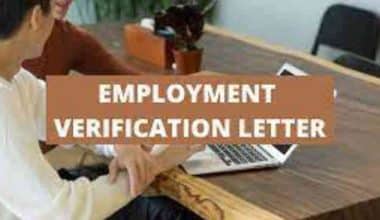When applying for a mortgage, a rental, or even to buy a car, you may need to show a letter of employment. A letter of employment, which is sometimes called a “verification of employment” is an official document that confirms your current or former status with an organization. This article talks about a verification letter of employment and a resignation or termination letter of employment.
Overview
A letter of employment, which is also called an employment verification letter, is written to confirm that a person is still working. Most of the time, financial institutions like mortgage companies and landlords need professionals to do this for them. When applying for a mortgage, a job, or even further schooling, you may be asked for a letter of employment. This lets the lender, employer, or school learn more about the applicant’s work history.
Managers and people who work in human resources (HR) often write these documents for workers who ask for them. Employment verification letters can be used to check on jobs from the past, present, or future.
Employer confirmation of employment is needed because it shows that the person has a steady source of income. The first step is to write a detailed request and send it to the right person in your company. If you want your letter of employment before you start your new job, make sure to ask for it a long time before you start.
It says that you are still working for the company and gives information about your position, length of service, whether you work full-time or part-time, salary, and the company that pays you. Most letters of employment verification are short because they only confirm salary and work status.
Why You Might Need an Employment Letter
There are a number of reasons why you might want to ask your employer for a letter of employment. The following is what you need in a letter of employment below;
#1. When Buying a New House
When buying a house or an apartment, everyone knows that they have to get a mortgage. Financial institutions like banks and credit unions will want to see proof of steady work when you apply for a loan.
#2. You’ve Decided to Move and Rent a New Place
Real estate agents and owners prefer tenants who will take care of their rent and pay it on time. So, they might want to see proof that you have a job before they let you rent. Here you are, whether you want to start the loan process from scratch or negotiate the terms of a loan you already have. When you apply for a loan, just like when you apply for a mortgage, the bank will usually ask for proof of steady work.
#3. You Have Decided to Look For Work Somewhere Else
If you are looking for a new job, a letter of employment from your current or most recent employer can be helpful. It’s proof that backs up what you say on your CV about your work history.
What a Letter of Employment Should Say
In most letters of employment, you will find the following:
- Details about the company.
- A letter of employment usually has the company’s name, address, and a way to get in touch with them.
- Information from outside sources.
- In these letters, both the name of the group asking for help and the name of the person to talk to there are given.
- Details on Personnel.
How to Write an Employment Letter
Consider the following tips if you need help writing a letter of employment for another professional.
#1. Use Proper Business Letter Format
The letter should be written in the style of a business letter. Include the name and address of your business, as well as any other contact information that might be useful. Next, include the date and address, as well as contact information for the person you are writing to. When writing a letter, use the recipient’s name if you have it. If not, use a more formal greeting, like “To whom it may concern” or “Dear Sir or Madam.”
#2. Justify Your Letter’s Existence
Since you want to get your point across quickly, it’s best to explain right away why you’re writing the letter. Once the other person understands what you mean, they can put your message in the right place. Use phrases like “I’m writing this letter to confirm that [employee name] is working” to make your point clear.
#3. Ensure That You Provide All the Information Requested
The contents of an employment letter can change based on what the recipient needs and what the employee wants to achieve. When writing a cover letter, it’s important to find out what information the professional wants to see. Just give them the information they specifically ask for in the letter. You can either make a list or say all of this in a few short sentences.
#4. Provide Your Contact Details
By giving the third party your email address or phone number, they can talk to you about the professional’s job. This lets you add any important information that wouldn’t fit in the letter itself. If potential employers want to know more about the professional’s job, it’s a nice gesture to be available to answer questions.
#5. Check the Letter for Mistakes
Use a formal greeting and sign your name to end your letter in a formal way. After you finish writing the letter, check its grammar and spelling. If you want your letter to sound professional and clear, it helps to read it again and pay attention to the tone.
Guidelines to Write an Employment Letter
Here are a few things to keep in mind when writing an employment letter:
#1. Use the Letterhead of the Company
When writing the offer letter, use the formal letterhead style of your company. Logos and ways to get in touch are often included. It’s not always necessary, but it can give the document an air of authority and credibility.
#2. Keep It Short and to the Point
In a letter, you can sum up your ideas by writing them in a clear, concise way. In order to do this, it is important to give only the bare minimum of information. Keep the letter short—no more than a paragraph or two—unless the person you’re writing to asks for more information. Check your finished work to make sure it says what you wanted it to say.
#3. Don’t Forget to Sign It by Hand
At the end of the letter, you don’t have to sign it, but some people may ask for it. The first step is to print the letter. Next, sign your name below your printed name and address. Scan your signed letter and save it as an attachment if you want to send it by email. Send an email with the file as an attachment and a short explanation of what it is.
#4. It Might Be a Good Idea to Let the Worker Read It
You might want to let the person you’re writing the letter for read it, but first, make sure that doing so doesn’t go against your company’s policy on employment verification letters. So you can be sure to tell them everything they need to know. This can be a simple way to fix any grammatical mistakes. Before you send out the employment letter, please check your company’s policies, as some have specific rules about how to write such letters.
#5. As Soon as Possible, Get It Out
Cover letters are very important because job offers are often part of a longer, more time-sensitive application. Get a deadline from the expert who asked for the letter before you start writing it. So, you should be able to finish the letter in a reasonable amount of time. Sending the letter early can help make sure it gets there on time, so do that if it’s easy for you. If you’re mailing the letter, don’t forget to figure out how long it will take to get there.
Verification Letter of Employment
In many fields, it is common to have a letter that confirms current or past employment. Depending on the third party’s need for employment verification and your company’s policies, this document may also confirm employment dates, salary, and other details.
Why Would an Employee Need a Letter to Confirm Their Employment?
An employee may ask for a letter confirming their current or past job. Here are the reasons:
- When an employee asks for a loan to buy a house or a car, the lender needs to know that the person is working and makes enough money to make the monthly payments.
- Before letting them move in, the property management company makes sure they can pay the deposit, rent, and any repairs or maintenance.
- The bank is thinking about their request to lower their loan payments or put them off for a while. The bank needs proof of their current income.
- They want to work for a different company, but first, they have to pass a background check.
- Employees who need a letter confirming their job status don’t have to say why they need it, but they should include all the information and contact details the recipient would need (e.g., address, a preferred method of delivery).
Resignation Letter of Employment
A resignation letter is a formal way for an employee to tell their boss that they want to leave their job as of a certain date. As a courtesy to your company, you should write a resignation letter so that they can start looking for your replacement. Also, your employment contract may say that you have to give a written letter of resignation.
To officially quit your job, you should send a resignation letter. Writing a formal letter of resignation and giving it to your boss is a good way to leave your job with class and leave a paper trail that can be used in the future if needed.
What to Write in a Resignation Letter of Employment
It’s fine to change the details of your resignation letter based on your job and the company, but there are some things you should always include, no matter what your job or employer is. All of these parts are part of what is being suggested:
- When your contract expires.
- Give your official last day of work, if possible, two weeks in advance.
- You should help make the change happen.
- Make it clear that you want the transition to go smoothly by being available to talk to your manager or your replacement about your work and any changes.
- You really appreciate the chance.
- No matter how bad your workplace is or how much you disagree with a coworker, you should always try to find something positive to say.
- How to Find Your Way (optional).
If you don’t already know how to leave your job, you should ask for detailed instructions about your last commitments and other things. A company may ask you to leave right away, involve you heavily in a transition over two weeks, let you work from home, and have you stop by HR on your last day to return your laptop.
What Shouldn’t Be In Your Resignation Letter of Employment?
In a resignation letter of employment, it is just as important to know what to say as it is to know what not to say. Many people make the common mistake of putting too much emotion and personal information into their formal communications. Don’t put the following in your formal letter of resignation:
#1. Is There a Reason You Want to Leave?
You can say more about why you’re leaving in a personal statement that isn’t part of your resignation letter. Rice says you shouldn’t say in your resignation letter that your new job has a better product, service, workplace, pay, or benefit package than your current one, even if you think it does. Always talk in a businesslike way that makes you feel good.
#2. What You Like Least About the Work
If you have any complaints or bad things to say about the company or the people you will no longer be working with, keep them to yourself, and don’t put them in your resignation letter. Roque said to let the letter cool down before sending it. She also said that you should have someone else look over your letter before you send it out to make sure it is clear and professional.
#3. Statements With a Lot of Feeling
Throughout the letter, Twersky stressed how important it was to keep a level head and act professionally. Writing a letter out of anger or other strong feelings will only make things worse. Even if you are tired and sick of your job, Twersky says you shouldn’t quit out of anger. If you don’t have something positive to say after “I feel” or “I think,” don’t use those phrases.
Keep in mind that you might need the person’s help in the future, so it’s best not to burn any bridges with a rude or dismissive letter.
Letter of Employment Verification Sample
A standard template for a job verification letter can make it easy to answer these questions. But employees (and former employees) should make their requests as soon as possible because it may take time to get the employee’s information and send the verification document to the other side. All requests for employment verification must be sent [by form, email, etc.] at least two working days in advance and include the following information:
- Name and address of the group that is looking.
- Instructions on how to ship and handle (e.g., fax number, mailing address, email address).
- Information that the person who asked must have (e.g., employment dates, job title, salary).
- Give details about why you want something (optional).
Please remember that it takes an average of five business days for documents sent by regular mail to arrive. Writing an employment verification letter for a current or former employee requires following a standard procedure, knowing state laws about what information can be shared, and giving correct information in a formal, clear way.
Because employment verification letters are used so often today (for things like mortgages, loans, leases, and job applications), it’s important to know how they work. Using a pre-written template for an employment verification letter can save time and make sure that the third party asking for the information gets all the information they need.
The Sample Letter of Verification of Employment
The following sample is a letter that can be used for verification of employment;
- A simple example of a letter to verify employment.
- Example of a letter of verification of employment for a former employee.
- An example of a formal letter of employment for a current employee.
- The sample employment verification letter includes a description of the work.
- A sample letter to verify employment for a visa.
- Get a sample letter you can send to your employer to confirm your job.
- Employment verification form for landlords of rental properties.
- Layout for a rental contract.
- Coverage for business costs that qualify.
- Policy for resolving financial disputes.
- Regulations for Telecommuting (Coronavirus Species CoV-19).
- A workplace without retaliation, harassment, or bias.
- Changing the way punishments work.
- Agreement for employment services to find new employees.
- A warning letter to an employee about harassment.
- Advice for employees who work from home.
- Dismissal Notice A letter telling an employee why they were fired.
- Plan for employees to protect information.
- Notice of proposal to work.
Termination Letter of Employment
A termination letter of employment tells a worker that he or she has been fired, explains what will happen next, and lists any benefits or money that may be owed to the worker. There are many names for a letter that serves as notice of the end of employment: a pink slip, a letter of termination, a letter terminating a contract, a letter of separation, and a notice of separation.
In the termination letter of employment, the official end of an employee’s time in a certain job at a company is called “termination of employment.” An employee can leave their job either because they want to or because their boss tells them to. Downsizing, poor performance, and being made redundant are all good reasons to get fired from a job.
How Do I Tell an Employee That Their Job Is Over?
A proper termination letter of employment should include the following:
- Fill in the employee’s name, ID number, job title, and division.
- Give the name and title of the person in charge of firing the employee.
- Think about all of the employee’s options, such as pay, benefits, and severance.
- Include all of the company property that the worker leaving must return.
- Pay attention to any agreements the worker has signed about keeping things secret or not working for other people.
- Have your lawyer look over the letter before you hit “send.”
What Is a Letter of Employment?
A job offer letter, which is also sometimes called an “employment letter,” is not legally binding the way a contract is. The letter has information about your pay and any possible deductions that may need to be made. jobs you have to do. Hours worked, among other things, are part of the terms and conditions of the job.
How Can I Write a Letter for Employment?
The following are;
- Details about the company.
- Details about the group that asked.
- Important things to know about the worker.
- Use the standard format for a business letter the whole time.
- Write about why you’re writing.
- Put in the information that the worker has asked to be included.
- Include your signature and information about how to reach you.
- Write about why you’re writing.
- Look over your letter carefully and fix any mistakes you find that is based on facts.
How Do I Write a Proof of Employment Letter?
To Whom It May Concern, Mr. or Mrs. Please consider this letter to be official confirmation that (employee name) has been working for (business name) since (start date). If you have any more questions about (employee name), feel free to email me at (your phone number).
What Is an Example of a Letter of Employment for a Visa?
Since [date], I, [First Name], and [Last Name], have worked for [Company Name] as a [designation]. Please accept my deepest respects. At the moment, [he/she] makes a gross annual salary of [xx,000] ([salary in words]) U.S. dollars.
How Do I Write a Letter of Employment in the U.S.?
The following are;
- Your legal name.
- You should provide us with some company details.
- In simple terms, it’s what you do to make a living.
- This is where you stand (part-time, full-time, contractor, or temporary employee).
- To be more specific, the beginning of your job.
- Salary.
- When there is a chance that things could change.
- How it’s meant to be used.
What Is Proof of Employment?
You can find out about a person’s work history by calling their current or previous employer. Employers make these kinds of materials, which are usually sent out by email or regular mail and have the company’s letterhead on them.
Conclusion
In a letter of employment, the person who sends the letter and the person who receives it may have different goals. A well-written cover letter can make or break an applicant’s chances of getting the job.
Letter of Employment FAQs
Why do I need to show proof of employment?
These letters from employers may be required by landlords or financial institutions when employees apply for a rental or mortgage. As an added bonus, they are often necessary for insurance coverage or to verify a candidate’s claimed employment history.
What is the difference between a job letter and an employment letter?
Both a letter of offer and a formal contract outlining the terms of employment should be used when hiring new employees. A job offer letter demonstrates professionalism and politeness. An employment agreement can shield an employee from needless common law responsibility.
Who requests a letter of employment?
If you work for a large company, you usually need to make a request to your HR department. In smaller businesses, however, where there isn’t a separate HR department, the request can be handled by the manager on duty.
Related Articles
- WHAT IS EMPLOYMENT VERIFICATION: All You Need To Know
- VERIFICATION OF EMPLOYMENT LETTER: How To Write One
- EMPLOYEE RESIGNATION LETTER: Format, Examples & Guide
- HOW TO WRITE A RESIGNATION LETTER: What You Should Say and Not Say
- RESIGNATION LETTER: Best Way to Write a Resignation Later






